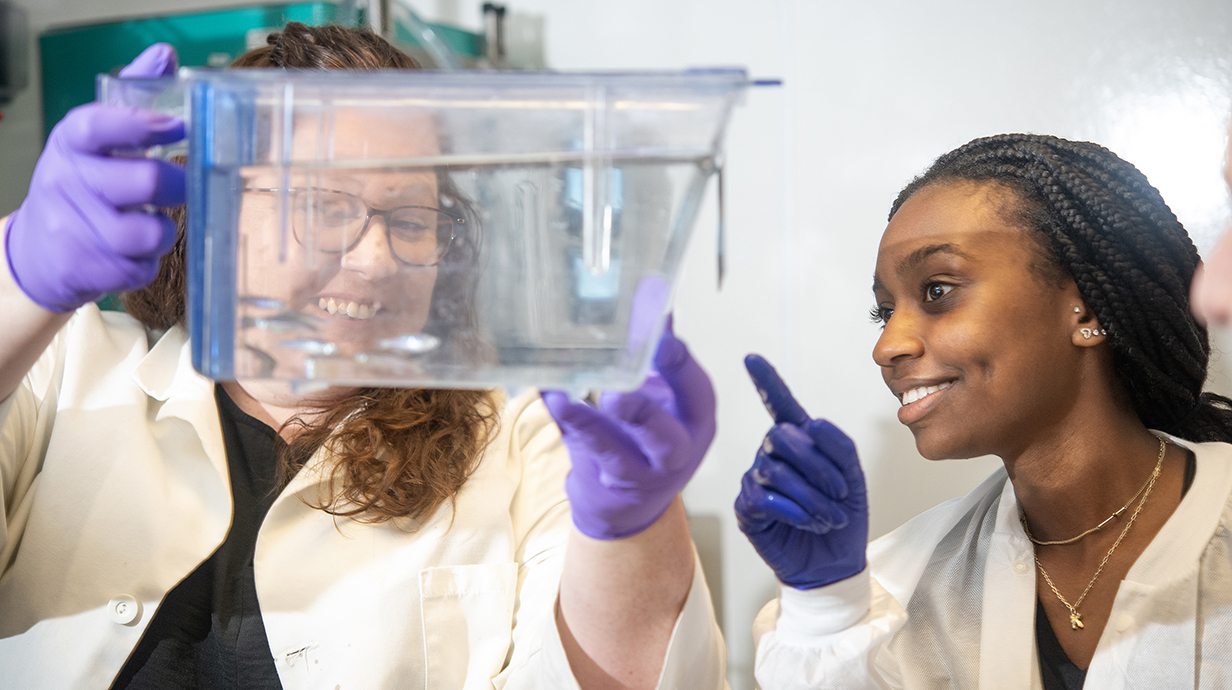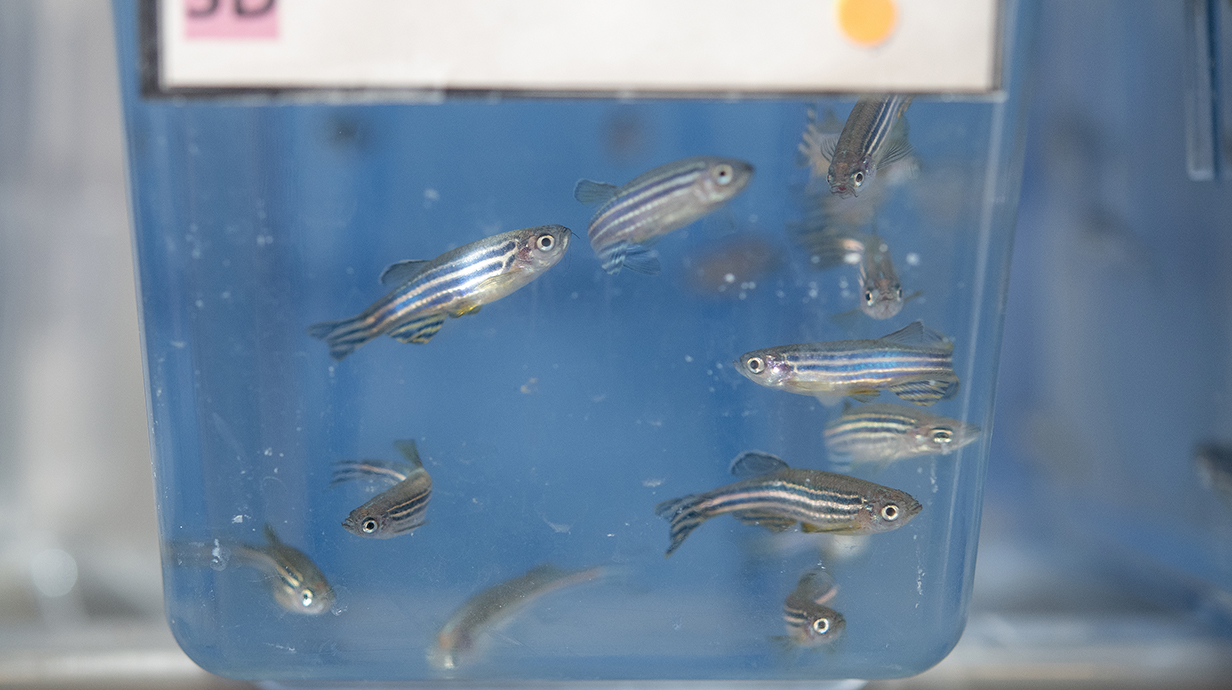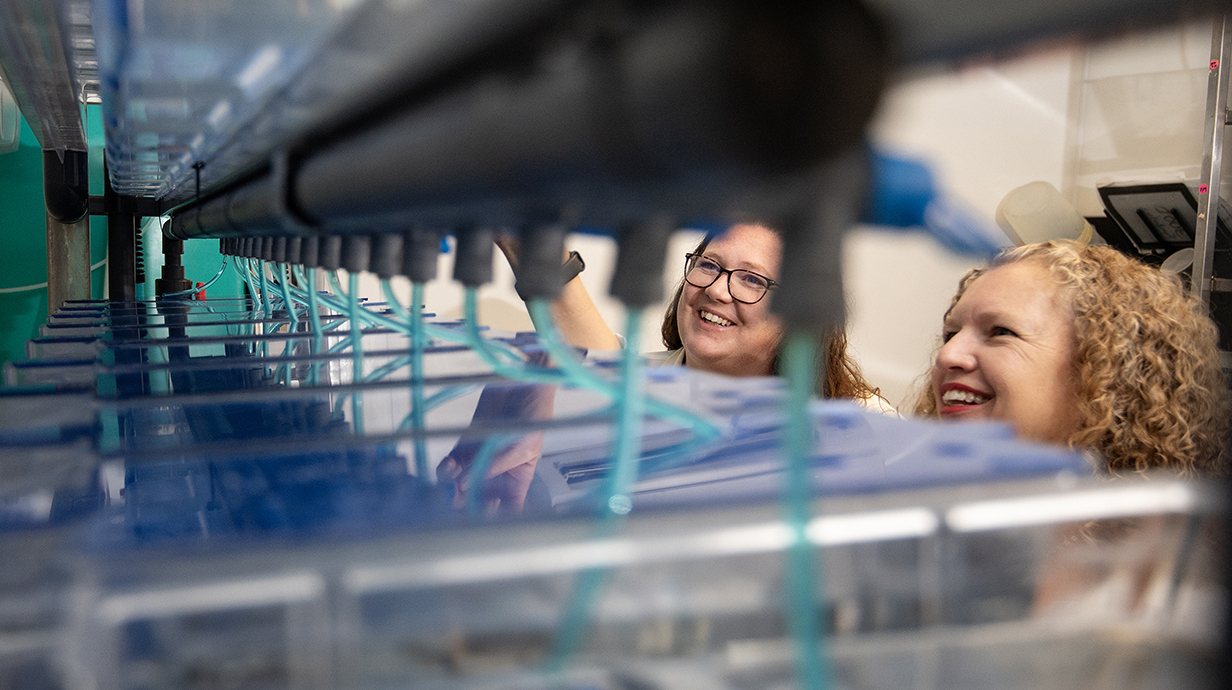Researchers Study Effect of Cannabinoids in Early Life
National Institutes of Health dedicates more than $2M to fund study
OXFORD, Miss. – New research from two University of Mississippi scientists aims to shed light on the potential effects of cannabis use during pregnancy.
The National Institutes of Health awarded toxicologist Kristine Willett and neuroscientist Nicole Ashpole more than $2.2 million to study the effects of cannabinoids – synthetic compounds or naturally occurring chemicals in cannabis – on zebrafish. Zebrafish are a type of minnow that shares 70% of human genes and that has a nervous system that closely resembles humans'.

Nicole Ashpole (left), associate professor of pharmacology, and Ka'Miya Dillon, a junior biochemistry major from Flowood, examine a container of zebrafish, which they are using to model the effects of cannabinoids on unborn children. Photo by Thomas Graning/Ole Miss Digital Imaging Services
"People have been using cannabis for centuries for treating things like nausea and vomiting," said Ashpole, associate professor of pharmacology. "So, I think a lot of people, when they're trying to turn to natural medicine during pregnancy, they think, 'Well, cannabis is safe.'
"We don't know that it is, but within the public, there's still a misconception."
The use of cannabinoids by pregnant women is on the rise, despite some indications that it may affect child development. One study found that percentage of American women who report using cannabis during pregnancy more than doubled from 3.4% in 2002 to 7% in 2017.
Women report using it to treat morning sickness, despite the possibility that cannabis use could cause impaired neurodevelopment, a higher chance of stillbirth and an increased likelihood of low birth weight.
"The biggest misconception is that we actually know what (cannabinoids) do," said Willett, professor of pharmacology and environmental toxicology and chair of the Department of BioMolecular Sciences. "We don't understand what they do. The field is way behind.

Zebrafish have nervous systems and development cycles that closely mimic that of humans. Photo by Thomas Graning/Ole Miss Digital Imaging Services
"A large part of it is the restrictions (on studying cannabis), but we're especially far behind with understanding cannabinoids in the early life situation. It's so widely available, yet we still don't understand it."
Zebrafish eggs develop as much in around 96 hours as humans do in nine months. So, by dosing zebrafish eggs with cannabinoids, the researchers can study how it affects the embryo throughout development in a matter of days.
"We've long used zebrafish for models in neuroscience as well, like in developmental toxicology, because we can see all of that early development," Ashpole said. "From the single-cell stage forward. If there's a defect, we could potentially see it.
"We're going to be looking microscopically at individual embryos and see what's going on in vivo in their brains."
Because zebrafish go through the same early developmental landmarks that humans do, Ashpole and Willett hope to determine not only the effect of cannabinoid exposure, but when it is most potent.

Nicole Ashpole (left) and Kristine Willett look at shelves of zebrafish tanks in their lab. Photo by Thomas Graning/Ole Miss Digital Imaging Services
"We can't break it into as simple terms as the first trimester versus the third trimester, but we may learn, for example, that after the spinal cord develops, you might have less of a risk, or after the eye is fully developed," Ashpole said.
"This is going to let us really look at those windows of susceptibility and see whether there is a safe time for exposure or if there is a point in development when it has the most damage."
Whether the researchers discover that cannabinoids negatively impact pregnancy, the ultimate goal is to better understand a field of research that has been challenging to study in the past, they said.
"This, for us, was about persistence," Willett said. "We've put this proposal in, in evolving ways, six times. We were so persistent because we think it is really important to understand cannabinoid toxicity or risks of cannabinoid exposure in early development.
"With this funding, now we can shed light on this issue."
This work is based on material supported by the National Institutes of Health grant no. 1R01DA057317-01A1.
Top: Ka'Miya Dillon (left), a junior UM biochemistry major from Flowood, removes a zebrafish from a tank for Nicole Ashpole, associate professor of pharmacology, and Kristine Willett, professor of pharmacology and environmental toxicology and chair of the Department of BioMolecular Sciences. They are using the minnows to study the effects of cannabinoids on unborn children. Photo by Thomas Graning/Ole Miss Digital Imaging Services
By
Clara Turnage
Campus
Published
August 21, 2024
